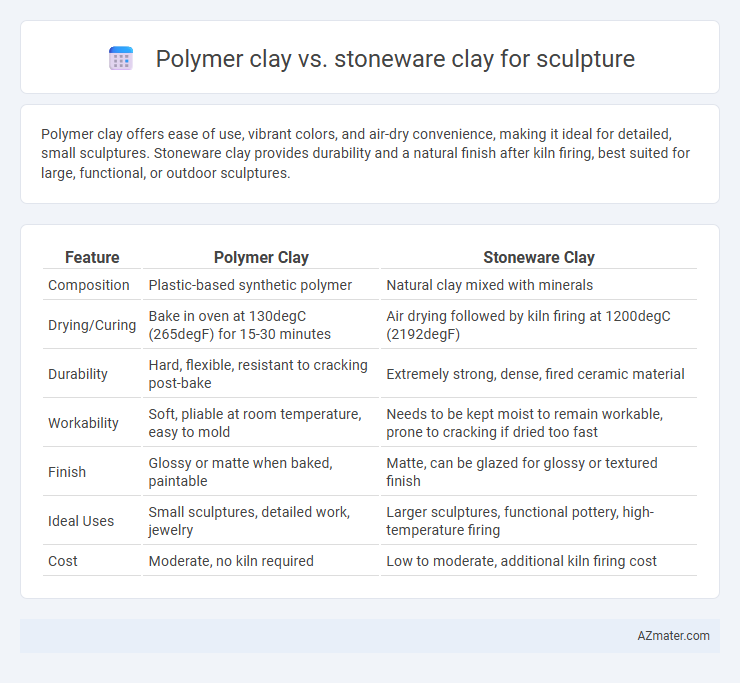Polymer clay offers ease of use, vibrant colors, and air-dry convenience, making it ideal for detailed, small sculptures. Stoneware clay provides durability and a natural finish after kiln firing, best suited for large, functional, or outdoor sculptures.
Table of Comparison
| Feature | Polymer Clay | Stoneware Clay |
|---|---|---|
| Composition | Plastic-based synthetic polymer | Natural clay mixed with minerals |
| Drying/Curing | Bake in oven at 130degC (265degF) for 15-30 minutes | Air drying followed by kiln firing at 1200degC (2192degF) |
| Durability | Hard, flexible, resistant to cracking post-bake | Extremely strong, dense, fired ceramic material |
| Workability | Soft, pliable at room temperature, easy to mold | Needs to be kept moist to remain workable, prone to cracking if dried too fast |
| Finish | Glossy or matte when baked, paintable | Matte, can be glazed for glossy or textured finish |
| Ideal Uses | Small sculptures, detailed work, jewelry | Larger sculptures, functional pottery, high-temperature firing |
| Cost | Moderate, no kiln required | Low to moderate, additional kiln firing cost |
Introduction to Polymer Clay and Stoneware Clay
Polymer clay is a synthetic modeling material composed primarily of polyvinyl chloride (PVC) that remains soft until baked at low temperatures, making it ideal for detailed, colorful sculptures and small-scale art. Stoneware clay, a type of ceramic made from natural clay fired at high temperatures (typically between 1,200degC and 1,300degC), offers durability, a robust texture, and a more traditional pottery feel, suitable for large or functional sculptures. While polymer clay hardens through an oven-curing process, stoneware undergoes kiln firing, resulting in vastly different physical properties and finishes for sculptural applications.
Composition and Material Properties
Polymer clay, composed mainly of polyvinyl chloride (PVC) and plasticizers, offers flexibility, lightweight properties, and ease of curing at low temperatures, making it ideal for fine detailing and indoor sculptures. Stoneware clay contains natural minerals like kaolin, feldspar, and quartz, providing high durability, thermal resistance, and a dense, vitrified finish after firing at high temperatures above 1200degC. The fundamental differences in polymer clay's synthetic composition versus the naturally derived, coarse granularity of stoneware influence their textures, drying processes, and long-term stability in sculptural applications.
Workability and Sculpting Techniques
Polymer clay offers exceptional workability due to its soft, pliable texture, allowing for intricate detailing and easy blending of colors without drying out during sculpting. Stoneware clay, while firmer and more resistant, provides a robust medium ideal for hand-building and wheel-throwing techniques but requires careful moisture control to prevent cracking. Sculptors often prefer polymer clay for fine, delicate work and quick adjustments, whereas stoneware clay excels in creating durable, textured pieces suited for high-temperature kiln firing.
Curing and Firing Processes
Polymer clay requires baking in a conventional oven at low temperatures, typically between 265degF and 275degF (129degC to 135degC), to cure and harden without the need for traditional firing. Stoneware clay demands high-temperature firing in a kiln, usually between 2100degF and 2300degF (1149degC to 1260degC), which vitrifies the clay and results in a durable, ceramic finish. The curing process for polymer clay is quicker and more accessible, whereas stoneware firing is complex, requiring precise temperature control and longer kiln cycles.
Durability and Longevity
Polymer clay offers moderate durability with resistance to cracking and fading, making it suitable for indoor sculptures but less ideal for outdoor exposure. Stoneware clay provides superior longevity due to its fired, vitrified nature, resulting in a highly durable, weather-resistant sculpture capable of lasting centuries. Artists prioritizing long-term durability and outdoor display often prefer stoneware clay over polymer options.
Artistic Flexibility and Detail
Polymer clay offers exceptional artistic flexibility with a smooth, pliable texture allowing intricate detailing and fine sculpting, ideal for miniature and complex designs. Stoneware clay, while less flexible, provides a robust medium suitable for larger, durable sculptures with a natural, textured finish that enhances tactile depth. Both materials serve distinct artistic needs, with polymer clays excelling in precision and stoneware clays in structural solidity and surface character.
Cost and Accessibility
Polymer clay offers a cost-effective and easily accessible option for sculptors, priced around $10 to $20 per pound and available at most craft stores and online retailers. Stoneware clay, typically costing $15 to $30 per 25-pound bag, requires access to a kiln for firing, which can add to overall expenses and limit convenience. The accessibility of polymer clay allows for immediate use without specialized equipment, while stoneware's durability and finish come with higher upfront costs and operational requirements.
Safety and Environmental Considerations
Polymer clay is made from synthetic materials and often contains plasticizers and chemical additives, raising concerns about indoor air quality and the release of potentially harmful substances when heated. Stoneware clay, composed of natural clay minerals, is generally non-toxic and safer for prolonged exposure, but firing it requires energy-intensive kilns that contribute to carbon emissions. Proper ventilation during polymer clay use and sustainable energy sources for stoneware firing are essential to minimize health risks and environmental impact.
Popular Uses in Sculpture
Polymer clay is widely favored for detailed miniature sculptures and jewelry due to its flexibility and ability to cure at low temperatures. Stoneware clay is preferred by sculptors for larger, durable art pieces and functional pottery because of its strength and high-temperature firing process. Artists often choose polymer clay for intricate, colorful works and stoneware clay for robust, long-lasting sculptures.
Choosing the Right Clay for Your Project
Polymer clay offers flexibility, vibrant colors, and ease of use for detailed or small-scale sculptures, making it ideal for intricate designs and indoor display. Stoneware clay provides durability, a natural texture, and a robust finish, suitable for larger or outdoor sculptures requiring firing in a kiln. Choosing the right clay depends on project size, desired finish, and whether kiln access is available for proper curing and strength.

Infographic: Polymer clay vs Stoneware clay for Sculpture
 azmater.com
azmater.com